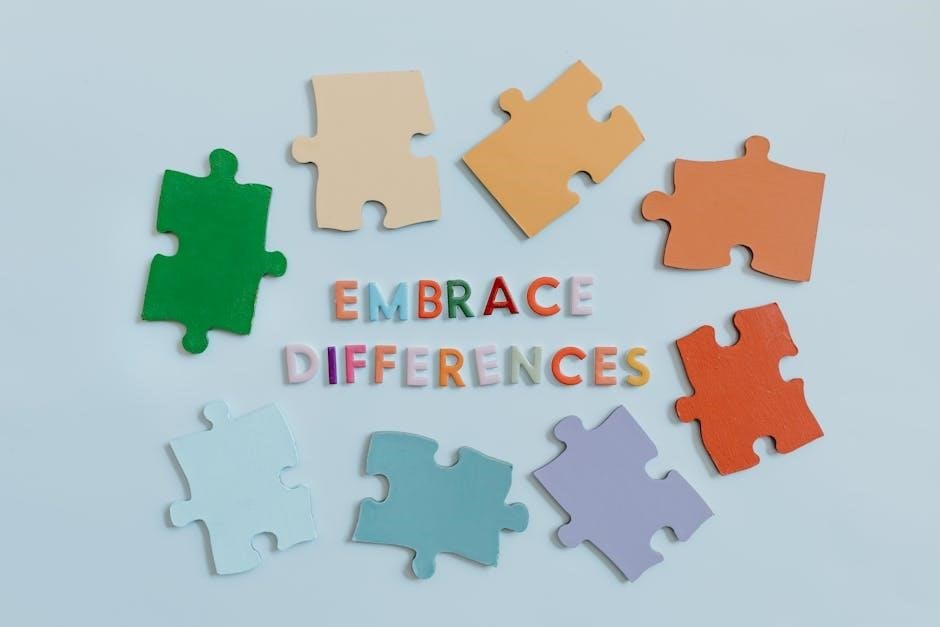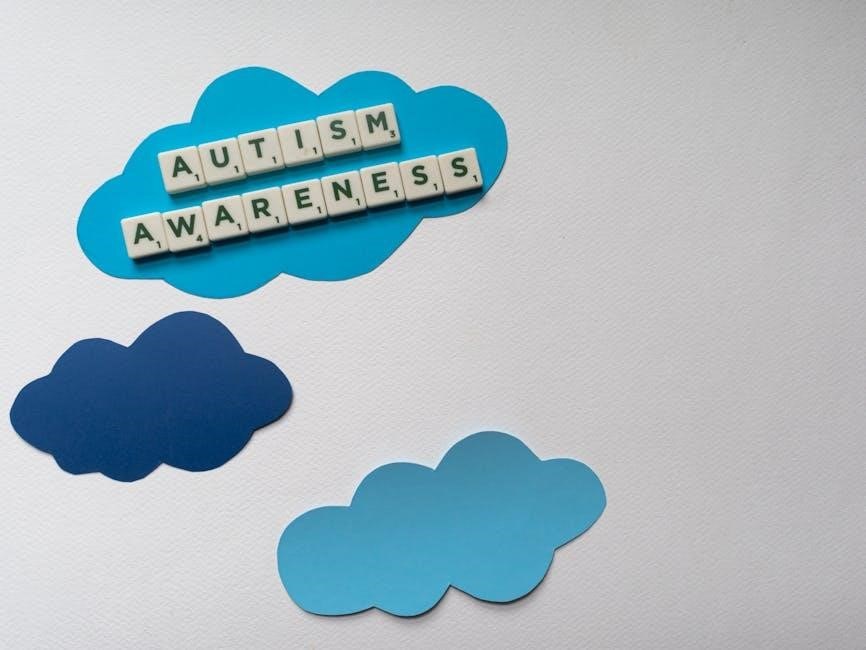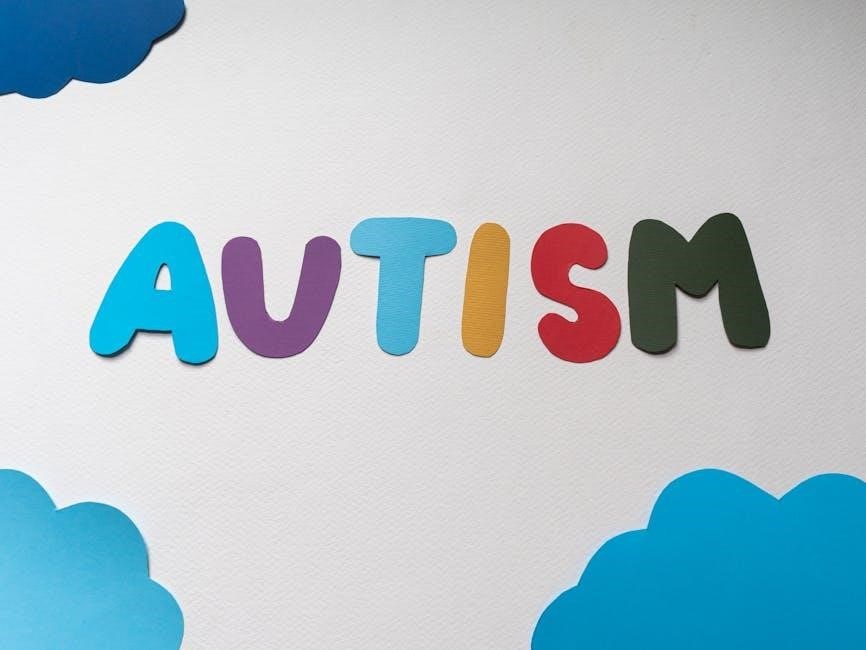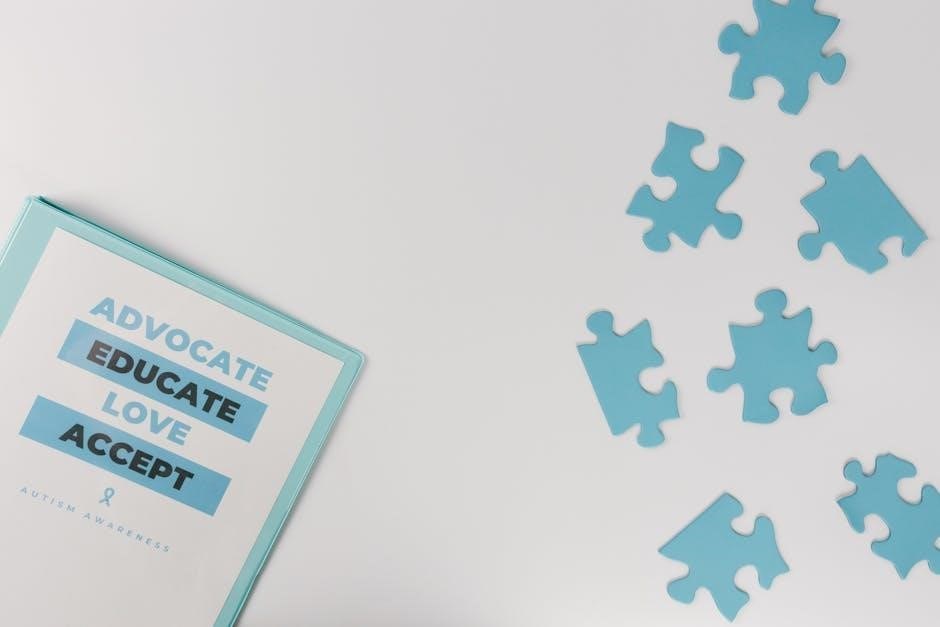Effective autism communication strategies involve
- structured approaches
and
- visual aids
to enhance social interactions and language development in individuals with autism spectrum disorder‚ as discussed in various online pdf resources.
Overview of Autism Spectrum Disorder
Autism spectrum disorder is a complex neurodevelopmental disorder that affects communication‚ social interaction‚ and behavior. According to various online resources‚ including pdf files‚ individuals with autism spectrum disorder may exhibit difficulties with verbal and nonverbal communication‚ such as understanding tone of voice‚ sarcasm‚ and idioms. The disorder is characterized by a range of symptoms‚ from mild to severe‚ and can affect individuals of all ages and backgrounds. Researchers and healthcare professionals have developed various
- diagnostic criteria
and
- assessment tools
to identify and evaluate autism spectrum disorder. Additionally‚ numerous studies have investigated the causes‚ symptoms‚ and treatment options for autism spectrum disorder‚ providing valuable insights for families‚ educators‚ and healthcare providers. By understanding the complexities of autism spectrum disorder‚ individuals can better support and accommodate those affected by the disorder‚ ultimately improving their overall quality of life and social interactions. Various online resources‚ including pdf files‚ offer in-depth information on autism spectrum disorder.
Importance of Communication in Autism
Effective communication is crucial for individuals with autism‚ as it enables them to express their needs‚ wants‚ and emotions. According to various online resources‚ including pdf files‚ communication plays a vital role in shaping social interactions‚ relationships‚ and daily experiences. Individuals with autism who possess strong communication skills are more likely to develop meaningful relationships‚ achieve academic success‚ and participate in community activities. Moreover‚ communication facilitates emotional regulation‚ reduces stress‚ and enhances overall well-being. The internet offers a wealth of information on communication strategies‚ including
- visual aids
and
- alternative communication systems
‚ which can be used to support individuals with autism. By prioritizing communication‚ families‚ educators‚ and healthcare providers can help individuals with autism lead more fulfilling and independent lives. Online resources and pdf files provide valuable guidance on promoting effective communication in autism‚ ultimately improving the quality of life for individuals with autism and their loved ones. Communication is essential for building trust‚ understanding‚ and strong relationships.

Communication Difficulties in Autism
Individuals with autism often experience social and
- language
difficulties‚ impacting daily interactions and relationships‚ as discussed in online pdf resources and studies.

Types of Communication Challenges
Individuals with autism spectrum disorder often face various types of communication challenges‚ including verbal and nonverbal difficulties‚ as outlined in online pdf resources and research studies. These challenges can manifest in different ways‚ such as struggling to initiate or maintain conversations‚ understanding tone and sarcasm‚ and developing social relationships. According to research‚ some individuals with autism may experience difficulties with verbal communication‚ including speaking in a flat or robotic tone‚ while others may have trouble with nonverbal communication‚ such as interpreting facial expressions and body language. Additionally‚ some individuals may exhibit
- echolalia
‚ where they repeat words or phrases without understanding their meaning. Understanding these different types of communication challenges is crucial in developing effective strategies to support individuals with autism. By recognizing and addressing these challenges‚ individuals with autism can improve their communication skills and enhance their social interactions.
Impact of Communication Difficulties on Daily Life
The impact of communication difficulties on daily life for individuals with autism spectrum disorder can be significant‚ affecting their ability to navigate social situations‚ form relationships‚ and participate in everyday activities. As discussed in online pdf resources‚ communication challenges can lead to feelings of isolation‚ frustration‚ and anxiety‚ making it difficult for individuals with autism to interact with others‚ express their needs‚ and understand social cues. This can result in difficulties with daily tasks‚ such as shopping‚ using public transportation‚ and engaging in leisure activities. Furthermore‚ communication difficulties can also affect an individual’s ability to access education‚ employment‚ and healthcare services‚ ultimately impacting their overall quality of life. By understanding the impact of communication difficulties‚ families‚ caregivers‚ and professionals can work together to develop strategies and provide support to help individuals with autism overcome these challenges and lead more independent and fulfilling lives‚ as outlined in various research studies and guides.

Strategies for Supporting Communication in Autism
Using visual aids and
- structured approaches
can enhance communication skills in autism‚ as discussed in online pdf resources and studies on autism communication strategies.
Alternative Communication Systems
Alternative communication systems are designed to support individuals with autism who struggle with verbal communication. These systems include methods such as picture communication symbols‚ manual signs‚ and electronic devices. According to various online resources‚ including pdf files and research articles‚ alternative communication systems can be highly effective in enhancing communication skills in individuals with autism. The use of
- visual aids
and
- structured approaches
can also facilitate communication and reduce frustration; Many organizations and researchers have developed alternative communication systems‚ such as the Picture Exchange Communication System (PECS)‚ which has been shown to be effective in promoting communication skills in individuals with autism. By using these alternative communication systems‚ individuals with autism can express their needs and wants‚ and interact more effectively with their environment. This can lead to improved social interactions‚ increased independence‚ and a better quality of life.
Manual Signs and Picture Communication Symbols
Manual signs and picture communication symbols are essential tools in autism communication strategies. These visual aids can be used to support individuals with autism who struggle with verbal communication. According to online pdf resources‚ manual signs can be used to teach individuals with autism to communicate their needs and wants. Picture communication symbols‚ on the other hand‚ can be used to create visual schedules‚ choice boards‚ and communication boards; The use of
- visual aids
such as pictures and symbols can help individuals with autism to understand and process information more effectively. Many researchers and organizations have developed manual signs and picture communication symbols‚ including the Picture Exchange Communication System (PECS). By using these tools‚ individuals with autism can express themselves more effectively‚ and interact with their environment in a more meaningful way‚ leading to improved social interactions and increased independence. This approach can be highly effective in promoting communication skills in individuals with autism.

Teaching Communication Skills to Individuals with Autism
Utilizing pdf resources and online tools to develop effective teaching methods for communication skills in individuals with autism spectrum disorder.
Curriculum and Programs for Communication Skills
Various curriculum and programs are available to teach communication skills to individuals with autism‚ including the Picture Exchange Communication System (PECS) and the Autism Communication Training program. These programs utilize a range of techniques‚ such as
- visual aids
‚
- role-playing
‚ and video modeling‚ to enhance social interactions and language development. Online resources‚ including pdf guides and tutorials‚ provide valuable information and support for educators and families implementing these programs. A comprehensive curriculum should include a combination of
- structured lessons
and
- flexible activities
to cater to the diverse needs of individuals with autism. By incorporating these programs and techniques into daily instruction‚ individuals with autism can develop essential communication skills‚ leading to improved relationships and increased independence. Effective curriculum design and program implementation are critical to ensuring the successful acquisition of communication skills in individuals with autism.
Basic Strategies for Supporting Children with Autism
Supporting children with autism requires a range of basic strategies‚ including creating a structured environment and establishing a daily routine. This can help reduce anxiety and improve communication. Using
- visual aids
such as pictures and schedules can also be beneficial. Additionally‚
- breaking down tasks
into smaller steps and providing positive reinforcement can help children with autism develop new skills. It is also important to identify and support individual needs and interests. By implementing these basic strategies‚ parents and educators can provide a supportive and inclusive environment that promotes social and communication skills. Online resources‚ including pdf guides‚ offer valuable information and tips for supporting children with autism. By working together and using these strategies‚ we can help children with autism reach their full potential and lead happy and fulfilling lives. Effective support strategies can make a significant difference in the lives of children with autism and their families.
